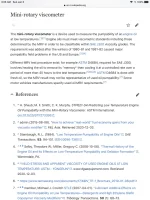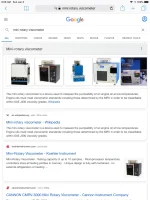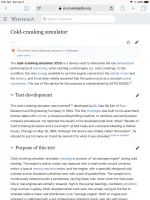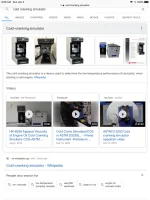No, because much of the power required to drive the pump has to do with the pressure it's working against, regardless of viscosity.If the diff is 1,000 to 1,500 in viscosity, wouldn't that mean 1.5x the work to pump the same volume for any given time period?
You are using an out of date browser. It may not display this or other websites correctly.
You should upgrade or use an alternative browser.
You should upgrade or use an alternative browser.
Kinematic Viscosity of motor oils at ambient temperature
- Thread starter Snagglefoot
- Start date
Thicker oil makes more pressure in the same oiling system (especially with very cold oil) when the oil is moved by the PD oil pump. But the difference in required pump power isn't much between the various viscosities when at full operating temperature (200+ F).
The power needed tracks with kinematic oil viscosity until the bypass valve opens. It's still several hundred watts, potentially
Using the equation for hydraulic HP = Pressure (psi) x flow Q (gpm) ÷ 1714 gives (assuming following conditions and 100% efficiency).
At idle (30 psi, 2 gpm)
(30 x 2) ÷ 1714 = 0.035 HP = 26 watts
At 6000 RPM (70 psi, 8 gpm)
(70 x 8) ÷ 1714 = 0.327 HP = 244 watts
Assuming 80% pump efficiency, then:
At idle, 32.5 watts to pump 2 gpm at 30 psi.
At 6000 RPM, 305 watts to pump 8 gpm at 70 psi.
At idle (30 psi, 2 gpm)
(30 x 2) ÷ 1714 = 0.035 HP = 26 watts
At 6000 RPM (70 psi, 8 gpm)
(70 x 8) ÷ 1714 = 0.327 HP = 244 watts
Assuming 80% pump efficiency, then:
At idle, 32.5 watts to pump 2 gpm at 30 psi.
At 6000 RPM, 305 watts to pump 8 gpm at 70 psi.
Snagglefoot
Thread starter
A Porsche website called rennlist.com but no further info on the actual source.What's the source of this graph?
Last edited:
Snagglefoot
Thread starter
And that’s a good point. I’ve tried to find better data with no success. Two simple data points would be good. The kinematic viscosity of a synthetic 5w30 at -40 and the same for a synthetic 5w40. The same brand would make it even better.The graph is what exactly? Full-synth oil all by same maker, or something different?
Edit: check out my posting #28. It has MRV data at -40 for both Mobil 5w30 and 5w40.
Last edited:
Using the equation for hydraulic HP = Pressure (psi) x flow Q (gpm) ÷ 1714 gives (assuming following conditions and 100% efficiency).
At idle (30 psi, 2 gpm)
(30 x 2) ÷ 1714 = 0.035 HP = 26 watts
At 6000 RPM (70 psi, 8 gpm)
(70 x 8) ÷ 1714 = 0.327 HP = 244 watts
Assuming 80% pump efficiency, then:
At idle, 32.5 watts to pump 2 gpm at 30 psi.
At 6000 RPM, 305 watts to pump 8 gpm at 70 psi.
The question is, where do you reach a certain psi. With a lower viscosity oil, it will be at a higher rpm. Stone cold it makes no difference, but somewhere in the warmup phase it will, and it certainly will when hot.
Snagglefoot
Thread starter
Good point. Here is an expanded version of the J300 chart. To qualify as a 5W, the oil has to have a MRV ( mini-rotary viscometer) reading of 60,000 cP or less. That is easy to meet with modern 5W oils. In fact, here is data from Mobil for their 5w30 and a 5w40. Have a look at the MRV for each. Also, notable is the the MRV for their 5w30 is much less than the MRV for their 5w40, but both are much less than 60,000 cP required by the SAE J300 requirements. Enjoy.when it comes to cold temp performance, has the technology reached a plateau?
any significant improvements in regard to mrv and ccs in the past 5 years?
sounds like pour point is not very relevant in the presence of mrv.
Last edited:
The oil pump output pressure and flow is determined by: 1) The oiling system total flow resistance, 2) The oil viscosity and 3) The pump performance curve based on pump design & engine RPM.The question is, where do you reach a certain psi. With a lower viscosity oil, it will be at a higher rpm. Stone cold it makes no difference, but somewhere in the warmup phase it will, and it certainly will when hot.
Yes, when the oil is stone cold, the pump pressure relief will open and the volume output will be cut back because the pump output will be limited to say 100 PSI if that's what the pressure relief is designed to. Using the equation in post #24, even if the oil was thick enough to make the pump (assume 80% efficient) run right at 100 PSI (but not in relief) with 10 GPM of flow (worse case scenario), the required HP would be 0.73 HP = 544 watts.
Jetronic - I'm curious where you got the numbers (formula?) you posted in post #20.
2kW of power to pump oil in an everyday passenger car seems pretty high based on the hydraulic HP equation I found.
I got them from a LUK presentation on oil pumps.
But I read it wrong I think...
https://www.schaeffler.com/remoteme...r_2/symposia_1/downloads_11/luk_k7_chap10.pdf
But I read it wrong I think...
https://www.schaeffler.com/remoteme...r_2/symposia_1/downloads_11/luk_k7_chap10.pdf
http://citeseerx.ist.psu.edu/viewdoc/download?doi=10.1.1.875.8678&rep=rep1&type=pdf
the pump in this paper needed 3 Nm drive torque at 3-4000 rpm, slightly dropping as rpm increased, that points to 1.5 bhp, slightly over 1 kw doing some headcalcs
the pump in this paper needed 3 Nm drive torque at 3-4000 rpm, slightly dropping as rpm increased, that points to 1.5 bhp, slightly over 1 kw doing some headcalcs
Isn't the puzzle a titch simpler than all of this belly button gazing?
I thought, honestly up to this point; that the so called "W' rating was simply determined by a certain volume of ice cold oil flowing through a known, standardized orifice bore diameter with the pull of gravity...Vs. time.
Am I hopelessly daft on this point?
I thought, honestly up to this point; that the so called "W' rating was simply determined by a certain volume of ice cold oil flowing through a known, standardized orifice bore diameter with the pull of gravity...Vs. time.
Am I hopelessly daft on this point?
Snagglefoot
Thread starter
Here is some info on the Mini Rotary Viscometer and the Cold Cranking Simulator. Yes, a bit more sophisticated than an orifice.Isn't the puzzle a titch simpler than all of this belly button gazing?
I thought, honestly up to this point; that the so called "W' rating was simply determined by a certain volume of ice cold oil flowing through a known, standardized orifice bore diameter with the pull of gravity...Vs. time.
Am I hopelessly daft on this point?




Okay.Here is some info on the Mini Rotary Viscometer and the Cold Cranking Simulator. Yes, a bit more sophisticated than an orifice.
Mind.
Officially.
Blown.
Nice touch that Dr. Kim refused to put his name on it too. Thanks for the clue!
key point being that the winter rating is only valid at the test temperatures. For the rest we have to depend on the summer rating and the viscosity index. Viscosity index most often tracks the winter rating though, but that's not necessarily always so.
Snagglefoot
Thread starter
Yes, there are usually no data points in between the CCS combined with the MRV, and the kinematic viscosity at 40 C. That a gap from around -35 C to plus 40 C. But really, the oil passes through all of this in 10 to 15 minutes.key point being that the winter rating is only valid at the test temperatures. For the rest we have to depend on the summer rating and the viscosity index. Viscosity index most often tracks the winter rating though, but that's not necessarily always so.
Figures 5 and 6 in the paper link shows around 700 watts in Fig 6 just before the 20 min mark, and the corresponding graph in Fig 5 shows at that's occurring at ~3800 RPM with the oil at ~90C. Could also be that oil pumps are not that efficient at pumping (worse than 80% as assumed). In Figure 11 they show a fixed displacement PD pump taking ~270 watts (maybe that's some kind of average in normal usage at lower RPM-?), so numbers seem to be all over the place. Anyway, interesting papers ... thanks for the links.I got them from a LUK presentation on oil pumps.
But I read it wrong I think...
https://www.schaeffler.com/remoteme...r_2/symposia_1/downloads_11/luk_k7_chap10.pdf
Last edited:
That graph is generated with the tool that will be back operating on my site (it died with the death of flash, so will be in html5). It is accurate down to zero or beyond, but has no way of knowing what pour point additives are in a given oil, or how good the synthetic is. You would need a lot more information than what is on the spec sheets to know when to force the curve to bend towards the actual cold start viscosity in cP
It is now working properly, although the format is not finished yet (size)
https://www.widman.biz/English/Calculators/Graph.html
https://www.widman.biz/English/Calculators/Graph.html
It is now working properly, although the format is not finished yet (size)
https://www.widman.biz/English/Calculators/Graph.html
Similar threads
- Replies
- 2
- Views
- 199
- Replies
- 24
- Views
- 1K
- Replies
- 16
- Views
- 1K
- Replies
- 43
- Views
- 2K

